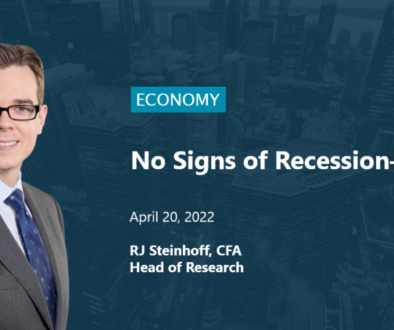A Cautious U.S. Economic Outlook
Our Economic Composite (TECTM) gave us a U.S. business cycle peak alert in March 2019, the first warning since the U.S. economic expansion began in 2009. Comprised of several economic variables, we developed the TECTM to monitor global business cycles and forewarn of potential business cycle peaks. Our research has shown that since 1965 each occurrence of a two-year rolling loss of 20% or more has been preceded by a business cycle peak.
As we wrote to clients in our Q2 2019 newsletter, we opted to not initiate any material hedges after the March TECTM alert as strong market gains are typically seen as the economic cycle is peaking. With the S&P 500 up over 15% from our alert to the end of 2019, we are pleased to have held off.
Since the alert, several key economic data points have weakened. Table 1 shows that unemployment is the only major economic data point that has improved since March.
Table 1. Change in Key U.S. Economic Data Points Since March 2019
| Data Point | Value as of March 31, 2019 | Latest Value (Date) | Direction |
|---|---|---|---|
| S&P 500 | 2,834 | 3,240 (Jan 3) | ↑ |
| 2019 S&P 500 EPS ESTIMATE | $168 | $162 (Jan 2) | ↓ |
| 2020 S&P 500 EPS ESTIMATE | $186 | $177 (Jan 2) | ↓ |
| 3 MONTH TREASURY | 2.39% | 1.53% (Jan 3) | ↓ |
| 10 YEAR TREASURY | 2.42% | 1.88% (Jan 3) | ↓ |
| REAL U.S. GDP (%Q/Q, SAAR) | 3.1% | 2.1% (Sept 30) | ↓ |
| IMF 2019 GLOBAL ECONOMIC GROWTH ESTIMATE | 3.5% (Jan 2019 report) | 3.0% (Oct 2019 report) | ↓ |
| U.S. UNEMPLOYMENT | 3.8% | 3.5% (Nov 2019) | ↑ |
| CAPACITY UTILIZATION | 78.4% | 77.3% (Nov 2019) | ↓ |
| ISM MANUFACTURING PMI | 55.3 | 47.2 (Dec 2019) | ↓ |
| ISM NON-MANUFACTURING PMI | 56.1 | 55.0 (Dec 2019) | ↓ |
| ATLANTA FED BUSINESS EXPECTATIONS INDEX | 96.0 | 90.6 (Nov 2019) | ↓ |
A few months after our TECTM alert, the New York Fed’s recession probability model—based on the Treasury spread—breached 30%. Since 1970, this model has never crossed 30% without a recession commencing in the subsequent months. As of November, that model’s recession odds have fallen to 25%.
The Federal Reserve responded to these weaker numbers by cutting rates three times in 2019, citing efforts to sustain the economic expansion. Balance sheet expansion has resumed; $400 billion has been added to the Fed’s balance sheet in the last few months. However, the Fed insists this current balance sheet operation is for “reserve management purposes” and not a large-scale asset purchase program (i.e., quantitative easing) intended to boost the economy.
The U.S. is not alone in looking for ways to shore up economic activity. In Japan, Prime Minister Abe announced a $240 billion fiscal program aimed at disaster repair, infrastructure, and counteracting consumption tax hikes and weakening economic data. China, rattled by the ongoing trade dispute, announced that the People’s Bank of China would follow September’s stimulus with another injection of $115 billion into the economy. The European Central Bank has recently urged governments in the Eurozone to boost public spending or cut taxes to combat faltering growth. The ECB itself starting buying €20 billion worth of bonds a month in November 2019 and reduced its deposit rate to -0.5%.
With global equities hitting new all-time highs, investors are clearly not worried about an economic slowdown in the near term. The consensus view appears to be that re-invigorated central banks have successfully stabilized the global economy through this soft patch, setting the stage for a resumption of global growth following the anticipated Phase 1 of the U.S.-China trade deal to be signed on January 15, 2020.
The current cycle has already seen two soft stretches in 2013 and 2016. Will 2019—buffeted by the U.S-China trade dispute, grounding of the 737 MAX 8, Hong Kong protests, and Brexit—go down as another soft patch in the post Great Recession expansion? Or is the yield curve inversion suggestive of something more ominous ahead for the U.S. economy?
For the first time since this cycle began, our firm now has a cautious economic outlook. With the S&P 500 trading at a healthy 14x EV/EBITDA, a resumption of economic growth is baked into the market. Our view is that this is far from certain and the high current valuations pose a risk of a correction if the economy fails to get back in gear.

RJ Steinhoff, CFA
Director of Research
DISCLAIMER
The information contained herein is for informational and reference purposes only and shall not be construed to constitute any form of investment advice. Nothing contained herein shall constitute an offer, solicitation, recommendation or endorsement to buy or sell any security or other financial instrument. Investment accounts and funds managed by Generation IACP Inc. may or may not continue to hold any of the securities mentioned. Generation IACP Inc., its affiliates and/or their respective officers, directors, employees or shareholders may from time to time acquire, hold or sell securities mentioned.
The information contained herein may change at any time and we have no obligation to update the information contained herein and may make investment decisions that are inconsistent with the views expressed in this presentation. It should not be assumed that any of the securities transactions or holdings mentioned were or will prove to be profitable, or that the investment decisions we make in the future will be profitable or will equal the investment performance of the securities mentioned. Past performance is no guarantee of future results and future returns are not guaranteed.
The information contained herein does not take into consideration the investment objectives, financial situation or specific needs of any particular person. Generation IACP Inc. has not taken any steps to ensure that any securities or investment strategies mentioned are suitable for any particular investor. The information contained herein must not be used, or relied upon, for the purposes of any investment decisions, in substitution for the exercise of independent judgment. The information contained herein has been drawn from sources which we believe to be reliable; however, its accuracy or completeness is not guaranteed. We make no representation or warranties as to the accuracy, completeness or timeliness of the information, text, graphics or other items contained herein. We expressly disclaim all liability for errors or omissions in, or the misuse or misinterpretation of, any information contained herein.
All products and services provided by Generation IACP Inc. are subject to the respective agreements and applicable terms governing their use. The investment products and services referred to herein are only available to investors in certain jurisdictions where they may be legally offered and to certain investors who are qualified according to the laws of the applicable jurisdiction. Nothing herein shall constitute an offer or solicitation to anyone in any jurisdiction where such an offer or solicitation is not authorized or to any person to whom it is unlawful to make such a solicitation.
Our Economic Composite (TECTM) gave us a U.S. business cycle peak alert in March 2019, the first warning since the U.S. economic expansion began in 2009. Comprised of several economic variables, we developed the TECTM to monitor global business cycles and forewarn of potential business cycle peaks. Our research has shown that since 1965 each occurrence of a two-year rolling loss of 20% or more has been preceded by a business cycle peak.
As we wrote to clients in our Q2 2019 newsletter, we opted to not initiate any material hedges after the March TECTM alert as strong market gains are typically seen as the economic cycle is peaking. With the S&P 500 up over 15% from our alert to the end of 2019, we are pleased to have held off.
Since the alert, several key economic data points have weakened. Table 1 shows that unemployment is the only major economic data point that has improved since March.
Table 1. Change in Key U.S. Economic Data Points Since March 2019
| Data Point | Value as of March 31, 2019 | Latest Value (Date) |
|---|---|---|
| S&P 500 | 2,834 | 3,240 (Jan 3) |
| 2019 S&P 500 EPS ESTIMATE | $168 | $162 (Jan 2) |
| 2020 S&P 500 EPS ESTIMATE | $186 | $177 (Jan 2) |
| 3 MONTH TREASURY | 2.39% | 1.53% (Jan 3) |
| 10 YEAR TREASURY | 2.42% | 1.88% (Jan 3) |
| REAL U.S. GDP (%Q/Q, SAAR) | 3.1% | 2.1% (Sept 30) |
| IMF 2019 GLOBAL ECONOMIC GROWTH ESTIMATE | 3.5% (Jan 2019 report) | 3.0% (Oct 2019 report) |
| U.S. UNEMPLOYMENT | 3.8% | 3.5% (Nov 2019) |
| CAPACITY UTILIZATION | 78.4% | 77.3% (Nov 2019) |
| ISM MANUFACTURING PMI | 55.3 | 47.2 (Dec 2019) |
| ISM NON-MANUFACTURING PMI | 56.1 | 55.0 (Dec 2019) |
| ATLANTA FED BUSINESS EXPECTATIONS INDEX | 96.0 | 90.6 (Nov 2019) |
A few months after our TECTM alert, the New York Fed’s recession probability model—based on the Treasury spread—breached 30%. Since 1970, this model has never crossed 30% without a recession commencing in the subsequent months. As of November, that model’s recession odds have fallen to 25%.
The Federal Reserve responded to these weaker numbers by cutting rates three times in 2019, citing efforts to sustain the economic expansion. Balance sheet expansion has resumed; $400 billion has been added to the Fed’s balance sheet in the last few months. However, the Fed insists this current balance sheet operation is for “reserve management purposes” and not a large-scale asset purchase program (i.e., quantitative easing) intended to boost the economy.
The U.S. is not alone in looking for ways to shore up economic activity. In Japan, Prime Minister Abe announced a $240 billion fiscal program aimed at disaster repair, infrastructure, and counteracting consumption tax hikes and weakening economic data. China, rattled by the ongoing trade dispute, announced that the People’s Bank of China would follow September’s stimulus with another injection of $115 billion into the economy. The European Central Bank has recently urged governments in the Eurozone to boost public spending or cut taxes to combat faltering growth. The ECB itself starting buying €20 billion worth of bonds a month in November 2019 and reduced its deposit rate to -0.5%.
With global equities hitting new all-time highs, investors are clearly not worried about an economic slowdown in the near term. The consensus view appears to be that re-invigorated central banks have successfully stabilized the global economy through this soft patch, setting the stage for a resumption of global growth following the anticipated Phase 1 of the U.S.-China trade deal to be signed on January 15, 2020.
The current cycle has already seen two soft stretches in 2013 and 2016. Will 2019—buffeted by the U.S-China trade dispute, grounding of the 737 MAX 8, Hong Kong protests, and Brexit—go down as another soft patch in the post Great Recession expansion? Or is the yield curve inversion suggestive of something more ominous ahead for the U.S. economy?
For the first time since this cycle began, our firm now has a cautious economic outlook. With the S&P 500 trading at a healthy 14x EV/EBITDA, a resumption of economic growth is baked into the market. Our view is that this is far from certain and the high current valuations pose a risk of a correction if the economy fails to get back in gear.
DISCLAIMER
The information contained herein is for informational and reference purposes only and shall not be construed to constitute any form of investment advice. Nothing contained herein shall constitute an offer, solicitation, recommendation or endorsement to buy or sell any security or other financial instrument. Investment accounts and funds managed by Generation IACP Inc. may or may not continue to hold any of the securities mentioned. Generation IACP Inc., its affiliates and/or their respective officers, directors, employees or shareholders may from time to time acquire, hold or sell securities mentioned.
The information contained herein may change at any time and we have no obligation to update the information contained herein and may make investment decisions that are inconsistent with the views expressed in this presentation. It should not be assumed that any of the securities transactions or holdings mentioned were or will prove to be profitable, or that the investment decisions we make in the future will be profitable or will equal the investment performance of the securities mentioned. Past performance is no guarantee of future results and future returns are not guaranteed.
The information contained herein does not take into consideration the investment objectives, financial situation or specific needs of any particular person. Generation IACP Inc. has not taken any steps to ensure that any securities or investment strategies mentioned are suitable for any particular investor. The information contained herein must not be used, or relied upon, for the purposes of any investment decisions, in substitution for the exercise of independent judgment. The information contained herein has been drawn from sources which we believe to be reliable; however, its accuracy or completeness is not guaranteed. We make no representation or warranties as to the accuracy, completeness or timeliness of the information, text, graphics or other items contained herein. We expressly disclaim all liability for errors or omissions in, or the misuse or misinterpretation of, any information contained herein.
All products and services provided by Generation IACP Inc. are subject to the respective agreements and applicable terms governing their use. The investment products and services referred to herein are only available to investors in certain jurisdictions where they may be legally offered and to certain investors who are qualified according to the laws of the applicable jurisdiction. Nothing herein shall constitute an offer or solicitation to anyone in any jurisdiction where such an offer or solicitation is not authorized or to any person to whom it is unlawful to make such a solicitation.



